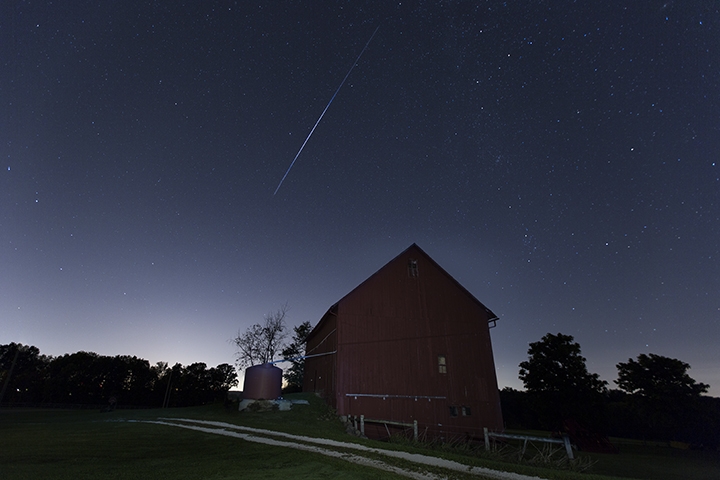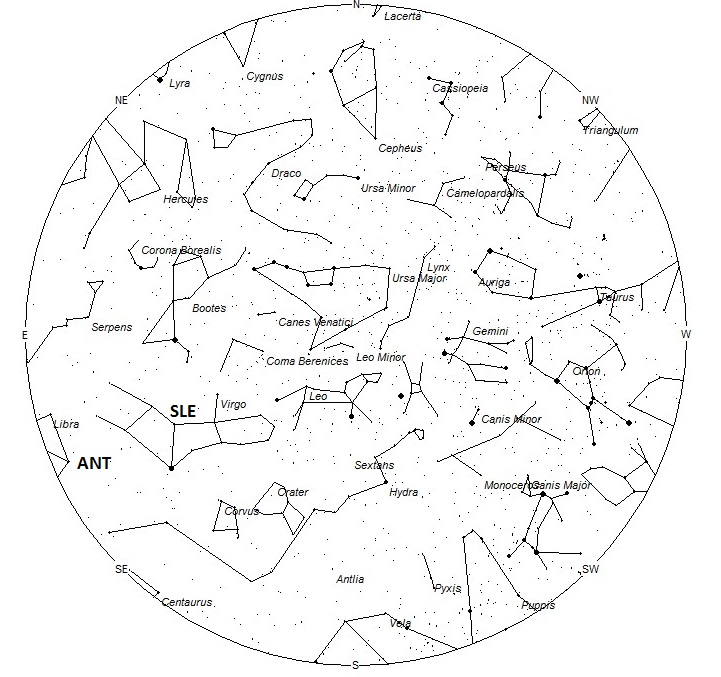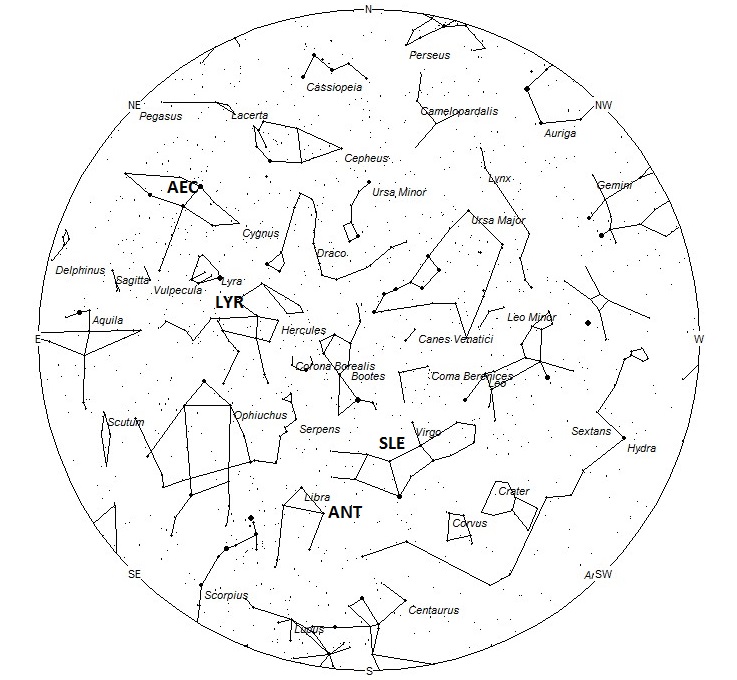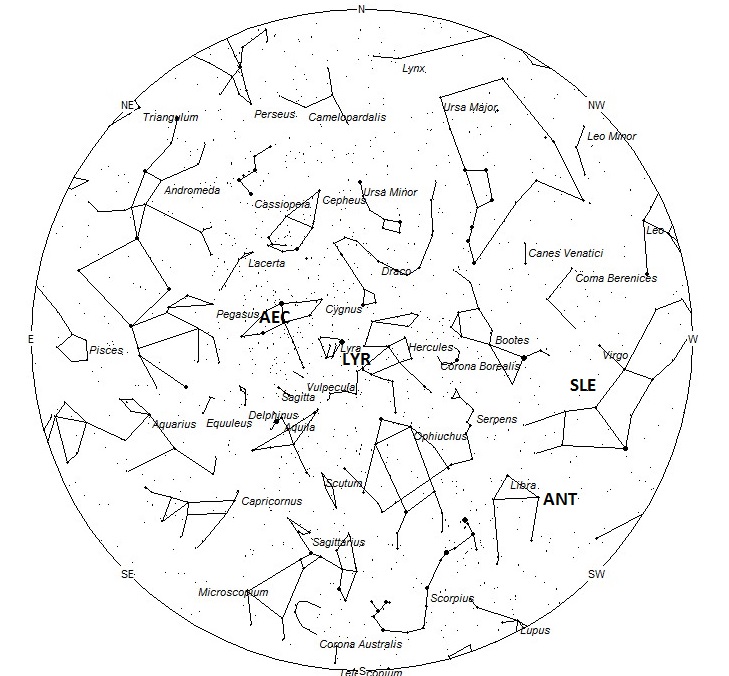
Photo shared on the American Meteor Society’s website – ©Debbie DiCarlo – 2014-09-23 21:55 – EDT
Composite image of three, 30-second images.
During this period the moon reaches its new phase on Saturday April 18th. At this time the moon will be located near the sun and will not be visible at night. Next week the waxing crescent moon will enter the evening sky but it will set prior to midnight and will not interfere with viewing during the more active morning hours. The estimated total hourly meteor rates for evening observers this week is near 3 for observers situated at mid-northern latitudes and 4 for observers viewing from the southern tropics (latitude 25 S.). For morning observers the estimated total hourly rates should be near 10 for observers situated at mid-northern latitudes and 13 for observers viewing from the southern tropics. The actual rates will also depend on factors such as personal light and motion perception, local weather conditions, alertness and experience in watching meteor activity. Note that the hourly rates listed below are estimates as viewed from dark sky sites away from urban light sources. Observers viewing from urban areas will see less activity as only the brightest meteors will be visible from such locations.
The radiant (the area of the sky where meteors appear to shoot from) positions and rates listed below are exact for Saturday night/Sunday morning April 18/19. These positions do not change greatly day to day so the listed coordinates may be used during this entire period. Most star atlases (available at science stores and planetariums) will provide maps with grid lines of the celestial coordinates so that you may find out exactly where these positions are located in the sky. A planisphere or computer planetarium program is also useful in showing the sky at any time of night on any date of the year. Activity from each radiant is best seen when it is positioned highest in the sky, either due north or south along the meridian, depending on your latitude. It must be remembered that meteor activity is rarely seen at the radiant position. Rather they shoot outwards from the radiant so it is best to center your field of view so that the radiant lies at the edge and not the center. Viewing there will allow you to easily trace the path of each meteor back to the radiant (if it is a shower member) or in another direction if it is a sporadic. Meteor activity is not seen from radiants that are located below the horizon. The positions below are listed in a west to east manner in order of right ascension (celestial longitude). The positions listed first are located further west therefore are accessible earlier in the night while those listed further down the list rise later in the night.
These sources of meteoric activity are expected to be active this week.
The Pi Puppids (PPU) are active from April 15-28 which maximum activity predicted to occur on the 24th. Some of these meteors may be seen from the southern hemisphere from a radiant located at 07:20 (110) -45. This area of the sky is located central Puppis, just southwest of the third magnitude star Sigma Puppis. This area of the sky is best seen as soon as it becomes dark during the early evening hours. No matter your location, rates are expected to be low. Observers located in the tropical northern hemisphere may also see some activity but at latitudes north of 30 degrees north, the odds are against seeing any activity at all. At 18km/sec. the Pi Puppids would produce meteors of very slow velocity.
The Sigma Leonids (SLE) are active from April 8-25, with maximum activity occurring on the 16th. This shower was discovered by Cuno Hoffmeister and published in his book Meteorstrome back in 1948. Recent refinements in the radiant position indicates that the actual location of the radiant lies further east than first thought, placing it in the constellation of Virgo instead of Leo. The radiant is currently located at 13:32 (203) +03, which places it in northern Virgo, 3 degrees north of the 3rd magnitude star known as Heze (Zeta Virginis). This radiant is best placed near midnight LDT, when it lies on the meridian and is located highest in the sky. Rates at this time should be less than 1 no matter your location. With an entry velocity of 19 km/sec., the average meteor from this source would be of slow velocity.
The center of the large Anthelion (ANT) radiant is currently located at 14:40 (220) -16. This position lies in western Libra, 3 degrees west of the 3rd magnitude known as Zubenelgenubi (Alpha Librae). Due to the large size of this radiant, Anthelion activity may also appear from eastern Hydra, northern Centaurus, and eastern Virgo as well as Libra. This radiant is best placed near 0100 LDT, when it lies on the meridian and is located highest in the sky. Rates at this time should be near 2 per hour as seen from the northern hemisphere and 3 per hour as seen from south of the equator. With an entry velocity of 30 km/sec., the average Anthelion meteor would be of slow velocity.
Activity from the Lyrid (LYR) shower reaches maximum activity on the morning of April 23rd with the radiant located at 18:08 (272) +33. This area of the sky is actually located in eastern Hercules, two degrees southwest of the faint star known as Kappa Lyrae. This position also lies six degrees southwest of the brilliant zero magnitude star Vega (Alpha Lyrae). The radiant is best placed just before the break of dawn when the radiant lies highest in the sky. While Lyrid meteors can be seen in both hemispheres, the north is favored as the radiant lies much higher in the sky. Hourly rates at maximum are expected to be near 15 shower members during the last couple of hours before dawn. South of the equator rates would most likely be near 5 Lyrids per hour. At 46km/sec. the Lyrids would produce meteors of medium-swift velocity.
The April Rho Cygnids (AEC) are active from April 11-May 4, with maximum activity occurring on the April 23rd. This shower was discovered by Dr. Peter Brown and associates using data from the Canadian Meteor Orbit Radar. The radiant is currently located at 20:44 (311) +43, which places it in central Cygnus, 2 degrees south of the 1st magnitude star known as Deneb (Alpha Cygni). This radiant is best placed during the last dark hour before dawn when it lies highest above the horizon in a dark sky. Rates at this time should be near 1 per hour as seen from the northern hemisphere and less than 1 as seen from south of the equator. With an entry velocity of 42 km/sec., the average meteor from this source would be of medium velocity.
As seen from the mid-northern hemisphere (45N) one would expect to see approximately 5 sporadic meteors per hour during the last hour before dawn as seen from rural observing sites. Evening rates would be near 2 per hour. As seen from the tropical southern latitudes (25S), morning rates would be near 10 per hour as seen from rural observing sites and 3 per hour during the evening hours. Locations between these two extremes would see activity between the listed figures.
The list below offers the information from above in tabular form. Rates and positions are exact for Saturday night/Sunday morning except where noted in the shower descriptions.
| SHOWER | DATE OF MAXIMUM ACTIVITY | CELESTIAL POSITION | ENTRY VELOCITY | CULMINATION | HOURLY RATE | CLASS |
| RA (RA in Deg.) DEC | Km/Sec | Local Daylight Saving Time | North-South | |||
| Pi Puppids (PPU) | Apr 24 | 07:20 (110) -45 | 18 | 18:00 | <1 – <1 | III |
| Sigma Leonids (SLE) | Apr 16 | 13:32 (203) +03 | 19 | 00:00 | <1 – <1 | IV |
| Anthelions (ANT) | – | 14:40 (220) -16 | 30 | 01:00 | 2 – 3 | II |
| Lyrids (LYR) | Apr 23 | 18:08 (272) +33 | 46 | 05:00 | <1 – <1 | I |
| April Rho Cygnids (AEC) | Apr 23 | 20:44 (311) +43 | 42 | 07:00 | 1 – <1 | IV |
 American Meteor Society
American Meteor Society


